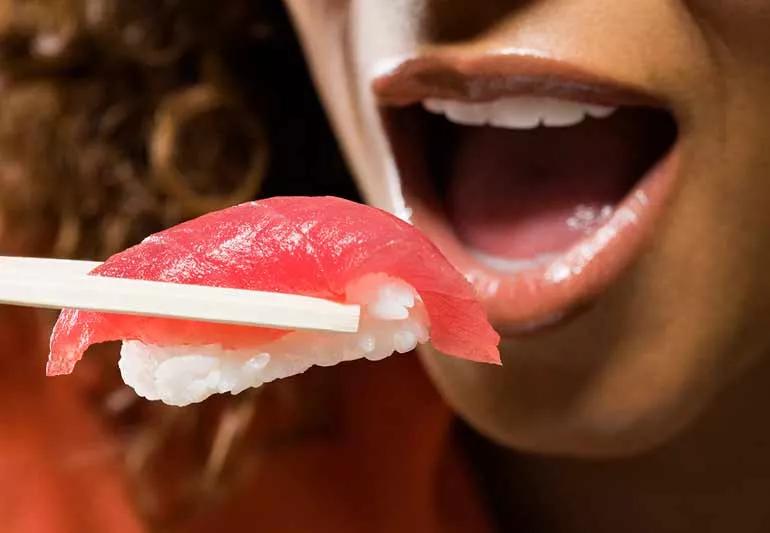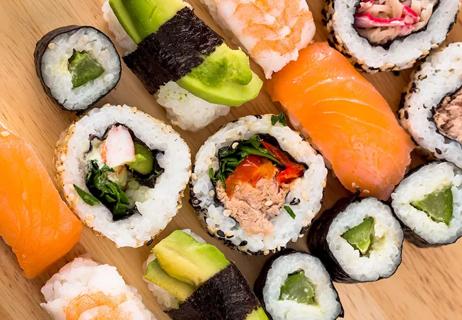For most healthy people, raw fish is safe, but following safety guidelines is key

Many countries around the world feature raw fish in their cuisine. From sushi to ceviche to crudo, these dishes are as beautiful as they are delicious — but should you really be eating raw fish?
Advertisement
Cleveland Clinic is a non-profit academic medical center. Advertising on our site helps support our mission. We do not endorse non-Cleveland Clinic products or services. Policy
While the health risk of eating raw fish is minimal for most healthy people, it can be serious for others. Foodborne illnesses in people who are healthy can be gross — vomiting, diarrhea, fever and abdominal pain are common. But for people who are over 65, under 5, pregnant or have a weakened immune system, the risk can be severe and even life-threatening illness.
Registered dietitian Beth Czerwony, RD, explains how to eat raw fish safely, the risks of eating raw fish and who should avoid raw fish dishes.
The only sure way to prevent foodborne illness is to cook the fish to an internal temperature of at least 145 degrees Fahrenheit (or 62.77 degrees Celsius). But if you really love that spicy tuna roll, there are some steps you can take to eat sushi safely.
Czerwony says, “As long as you’re healthy, it’s just a matter of finding the right supplier and making sure the food is prepared in a healthy way.”
She recommends you:
You can tell a lot about a fish by how it looks, feels and smells, says Czerwony. Check that:
Where you purchase your raw fish matters. Gas station sushi may seem fast and easy, but it’s probably not a good idea if it contains raw fish.
Advertisement
Only purchase raw fish from reputable sources, says Czerwony. The facility should be clean and the workers should practice good hygiene. If you’re in a restaurant, look up the sanitation score from their last food safety inspection.
You may think fresh fish is best when eating it raw, but that’s not always the case. Freezing kills parasites that can make you sick.
The U.S. Food and Drug Administration (FDA) recommends that you either freeze fish at -4 F for seven days (or -31 F for 15 hours if you need to freeze it more quickly).
But not all fish needs freezing. According to the FDA, freezing isn’t necessary for most types of tuna or for farmed fish raised in open water pens, ponds or tanks.
“Before you purchase or order raw fish, ask whether it was frozen,” advises Czerwony. “A reliable source will know the standards and whether their fish meets those standards.”
If you’re preparing raw fish at home, food safety is essential. “By handling food safely, you reduce the chance that any bacteria on the raw fish will grow or spread to other foods,” says Czerwony.
The best steps you can take are to:
Mercury is a toxic metal found in most types of fish. It poses a health risk whether the fish is raw or cooked. Fish higher up on the food chain (the ones that eat smaller fish) have the highest levels of mercury.
Low-mercury fish include:
Fish with the highest mercury include:
Because of the mercury levels in fish, the FDA recommends people who are pregnant and children limit the amount of fish they eat. In general, the FDA suggests only a few servings of fish with low mercury levels per week.
According to the Centers for Disease Control and Prevention (CDC), 48 million people get sick, and 3,000 people die from foodborne illnesses each year in the U.S.
The most common foodborne illnesses associated with raw fish include:
Advertisement
Dining on raw fish can be a mouth-watering culinary experience. But for some, the satisfaction of eating a gourmet dish just isn’t worth the risk of illness, notes Czerwony.
You shouldn’t consume raw fish if you’re:
Fish is an excellent source of protein and is rich in omega-3 fatty acids that may improve heart health and reduce inflammation. And as heat can destroy some of the omega-3 fatty acids, raw fish can be even better for you than cooked fish.
“Food is such an important part of our physical and emotional lives,” says Czerwony. “If you are healthy and take some sensible precautions, go ahead and enjoy your favorite sushi roll or sashimi.”
Advertisement
Learn more about our editorial process.
Advertisement

From your head to your heart, shrimp can provide some solid benefits

Eat this fatty fish two times a week to support your muscle, brain and heart health

Salmon and herring are some of the best choices

Debating the health benefits and risks

The benefits of eating this ‘nutritional powerhouse’

The best rolls, sashimi and appetizers you can eat

The health benefits of these shelled beauties just might convert you

The best parenting style balances enforcing rules and showing plenty of love

Tips include cutting back on sugar, focusing on exercise and managing stress

It can be harder to let go when you’ve invested time, energy and emotions — but it might be the healthier choice long term